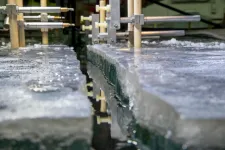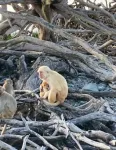Geological riddle solved: Roof of the World has gotten higher
There has long been controversy about whether the world's highest region, Tibet, has grown taller during the recent geological past. New results from the University of Copenhagen indicate that the 'Roof of the World' appears to have risen by up to 600 met
2021-05-26
(Press-News.org) GEOLOGY There has long been controversy about whether the world's highest region, Tibet, has grown taller during the recent geological past. New results from the University of Copenhagen indicate that the 'Roof of the World' appears to have risen by up to 600 meters and the answer was found in underwater lava. The knowledge sheds new light on Earth's evolution.
Tibet is referred to as the Roof of the World for good reason. With an average altitude of 4,500 meters above sea level and the world's two highest peaks, Mount Everest and K2, the vast Himalayan mountain range towers higher than anywhere else on Earth.
But the Tibetan plateau's height has been the subject of academic controversy for many years. Some researchers believe that the area has been as high as it is today for most of its existence, while others believe that the area has increased in height over the past 20 - 30 million years. It is a riddle that until recently has stood and flickered unanswered in the wind.
With the help of new analyses of the Indian Ocean seabed and calculations of the movement of Earth's tectonic plates, a researcher from the Department of Geosciences and Natural Resource Management at the University of Copenhagen has contributed new answers to the disagreement.
"By looking at older data of Tibet's emergence and combining it with new geological data from the Indian Ocean, we are pretty certain that there was a major geological change in Tibet about 15-18 million years ago, one that caused the wide area to rise between 300 and 600 meters," explains Associate Professor Giampiero Iaffaldano, the study's main author.
A slow, head on collision between the India subcontinent and Eurasia
The change is due to a head on collision between what are today India and China. India was originally located much further south, but the tectonic plate upon which India lies gradually moved northwards over millions of years and closer to China, until they finally collided to form Tibet.
Using plant fossils and geochemical analyses of rocks found in the mountainous region, some scientific researchers have been quite sure that Tibet looked the way it does today as far back as 20-30 million years ago and that its altitude has not changed over time.
Other researchers have believed that the prolonged and decelerating collision between India and China was caused by Tibet shooting upwards as much as two kilometers over a few million years. But according to Associate Professor Giampiero Iaffaldano, the answer is found somewhere in between.
"What the study contributes to, is actually a combination of the two previous hypotheses, different data sets and conclusions. What I've done is take a closer look at the speed of the India-China collision using Indian Ocean geological data that has only recently become available to the public," he says.
Finding an answer at the bottom of the Indian Ocean
Continuously through time, hot stones and other material are spat from Earth's interior onto the ocean floor. They have much to reveal about the movements of Earth's tectonic plates. Encoded within these lavas are records of Earth's magnetic polarity - the direction of Earth's north and south poles.
Polarity has reversed several times in Earth's history, meaning that North has become South and vice-versa. And, scientific researchers know roughly when these flips occurred. As such, they can trace tectonic plates to specific places and times during Earth's history using their magnetization along a so-called geomagnetic timescale.
"A closer look at this type of data held the answer to the question of whether Tibet has gotten higher or not. It has proven tremendously useful to calculate the speed of India's collision with China from geomagnetic data. More and more of such data, often originally collected for purposes other than fundamental scientific research and thereby not publicly available, is now being released and used by scientists," explains Giampiero Iaffaldano and adds:
"This new knowledge about Tibet is important for better understanding of Earth's evolution and the metods used could turn out usefull in future studies."
INFORMATION:
Facts:
The Tibetan plateau stretches over 1,000 kilometers from North to South and 2,500 kilometers from East to West.
Tibet has been extensively studied by geologists because it reveals important details about Earth's geological development and the movement of continents.
There are seven large continents on Earth, each of which is in constant flux and give rise to earthquakes, etc.
ELSE PRESS RELEASES FROM THIS DATE:
2021-05-26
The goal of Kaare Hartvig Jensen, Associate Professor at DTU Physics, was to reduce the need for harvesting, transporting, and processing crops for the production of biofuels, pharmaceuticals, and other products. The new method of extracting the necessary substances, which are called plant metabolites, also eliminates the need for chemical and mechanical processes.
Plant metabolites consist of a wide range of extremely important chemicals. Many, such as the malaria drug artemisinin, have remarkable therapeutic properties, while others, like natural rubber or biofuel from tree sap, have mechanical properties.
Harvesting cell by cell
Because most plant metabolites are isolated in individual cells, the method ...
2021-05-26
When do bees sting and how do they organise their collective defence behaviour against predators? An interdisciplinary team of researchers from the Universities of Constance and Innsbruck has provided new insights into these questions. Their study, published in BMC Biology, combined behavioural experiments with an innovative theoretical modelling approach based on "Projective Simulation". It shows that individual bees decide whether to sting - or not - based on the presence and concentration of an alarm pheromone. The scientists suggest that each bee has a likelihood of stinging that is not constant, but shows at least two internal thresholds for the concentration of the pheromone: one to start stinging and one to stop stinging. The computational modelling also revealed how several environmental ...
2021-05-26
A long-standing theory assumes that terrestrial plants could only have developed by entering into a symbiosis with fungi, whereby the two organisms exchange resources in a mutually beneficial way. A new study by an international group of scientists has now confirmed this theory. By studying a liverwort species (a bryophyte related to mosses), the scientists succeeded in demonstrating that a lipid transfer takes place between the plant and the fungus similar to that already known to exist in plants with stems and roots - so called vascular plants. The study was led by French researchers from the Centre national de la recherche scientifique (CNRS) and the Université de Toulouse III - Paul Sabatier, in collaboration with the ...
2021-05-26
Researchers at Aalto University in Finland have found strong evidence that warm ice - that is, ice very close in temperature to zero degrees Celsius - may fracture differently than the kinds of ice typically studied in laboratories or nature. A new study published in The Cryosphere takes a closer look at the phenomenon, studied at the world's largest indoor ice tank on Aalto's campus.
Understanding how ice breaks is crucial for ensuring safe harbours and bridges in cool climates, as well as transportation through historically ice-heavy regions. As global warming brings changes to once-predictable seasonal conditions, the rules underpinning infrastructure ...
2021-05-26
A paper published in the Journal of Clinical Medicine presents the results from a study which examined the use of an infrared thermal imaging camera as a novel non-invasive point-of-care tool for lymphatic filariasis lower-limb lymphoedema.
Thermal imaging has been used for several decades in a wide range of medical disciplines, but this is the first time it has been used for filariasis or any skin neglected tropical disease (NTD).
LSTM's Dr Louise Kelly-Hope led the research. She said: "Infrared thermal imaging presents an innovative and objective method for quantifying clinical change in filarial lymphoedema status by using naturally emitting infrared radiation to capture skin surface temperatures. This ...
2021-05-26
A recent study finds that the vast majority of Black adolescents have experienced racism, that they experience anticipatory stress about experiencing racism again, and that their racial identity can influence that stress in a variety of ways.
"We know that racism is stressful," says Elan Hope, corresponding author of the study and an associate professor of psychology at North Carolina State University. "Part of that stress is anticipatory - waiting for the next racist thing to happen. But not everyone experiences this stress the same way. We wanted to know how racial identity may influence ...
2021-05-26
Non-parents expand the range of their facial expressions in caring for infants among primates, a team of anthropologists has found. The study shows the ability, among non-relatives, to both decipher facial expressions and to be attuned to others' emotional states, revealing the evolutionary nature of communication.
The research, which appears in the journal Evolution, focused on the relationship between alloparenting, or infant care by non-parents, and the adoption of detailed facial expressions across more than 30 species of primates.
"Our results confirm previous work indicating ...
2021-05-26
FinBIF, which is coordinated and developed by the Finnish Museum of Natural History Luomus of the University of Helsinki:
digitises natural history specimens and produces digital DNA barcodes
collects born-digital observation records of professionals and amateurs alike
integrates data collated from different sources
distributes the data mass as open data
offers data management services, such as platforms for recording and publishing monitoring data and for reporting observations, to researchers, the environmental administration and the public
Typically, different types of species data and the different stages of the data life cycle, that is, digitisation, collection, ...
2021-05-26
Whether in desalination, water purification or CO2 separation, membranes play a central role in technology. The Helmholtz-Zentrum Hereon has been working for several years on a new variant: it consists of special polymers that form pores of the same size on the nanometer scale. The materials to be separated, such as certain proteins, can literally slip through these pores. Because these separation layers are very thin and thus very fragile, they are bound to a spongey structure with much coarser pores, providing the structure with the necessary mechanical stability.
"A special aspect is that these structures form in an act of self-organization," says Prof. Volker Abetz, director of the Hereon Institute of Membrane Research and professor of physical chemistry at the University ...
2021-05-26
Current wireless networks such as Wi-Fi, LTE-Advanced, etc., work in the lower radio spectrum, below 6 GHz. Experts warn that soon this band will become congested due to mushrooming data traffic. It is calculated that by 2024, 17,722 million devices will be connected.
To meet the growing, ubiquitous demand for wireless broadband connectivity, communication via the terahertz band (THz) (0.1 to 10 THz) is seen as a necessary choice for 6G networks and beyond, due to the large amount of available spectrum in these frequencies.
A study published in the IEEE Journal on Selected Areas in Communications presents a new communication design that ...
LAST 30 PRESS RELEASES:
[Press-News.org] Geological riddle solved: Roof of the World has gotten higher
There has long been controversy about whether the world's highest region, Tibet, has grown taller during the recent geological past. New results from the University of Copenhagen indicate that the 'Roof of the World' appears to have risen by up to 600 met





